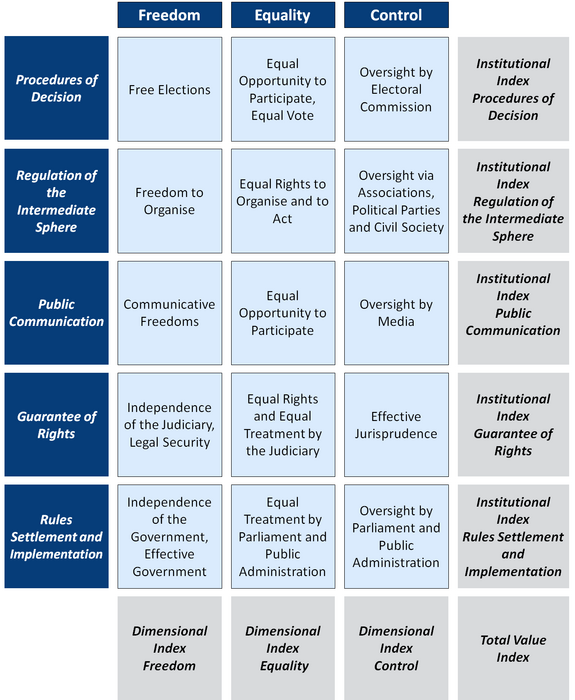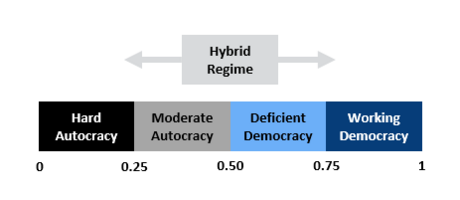On the one hand, we here describe the different aggregation rules comprised by the applied calculation steps, in the sense of a bottom-up movement from the indicators, by way of the subcomponents or components, to the formation of the total value of a matrix field. On the other hand, we also present here the procedure used in the calculation of the levels of aggregation of the democracy matrix in the form of dimension value, institution value and total value. Finally, we discuss the regime classification of the democracy matrix on the basis of core and context measurement. Further information can be consulted in the Codebook of the democracy matrix.
1. Aggregation Rules for Calculating the Individual Matrix Fields
We here describe the aggregation rules represented in the concept trees. They make possible the measurement of democracy quality, inasmuch as indicators can be bundled into subcomponents or components and, ultimately, matrix fields in the form of a bottom-up perspective.
Aggregation Rules | Objective |
|---|---|
Cumulative distribution function (CDF) followed by min-max transformation | This rule brings about a transformation of the V-Dem values of the measurement model, which move along a scale between -5 and 5, onto a scale between 0 and 1. A student’s t-distribution (df = 6) is used here for the transformation of the z-standardised values. A degree of freedom of 6 assures that a strong deviation from the standard normal distribution is prevented; the extremes of the scale can, nonetheless, be better differentiated (see V-Dem). A figure comparing the two distributions is here. The lowest value is then set to 0 and the highest value raised to 1, in order to use the full range of the scale. Most of the values already extend from 0 to 1 after the CDF, however, such that the distorting effect, in the sense of an artificial increase of the distances between empirical cases, is very limited. This only has an influence for variables with unusual distributions. |
Average or weighted average | This rule allows for compensation between components or subcomponents of a concept. The weighing gives expression to the fact that, due to considerations in democracy theory, certain components or subcomponents are conferred a higher value for the determination of democracy quality. |
Multiplication followed by root extraction | This aggregation rule only allows for a limited possibility of compensation between the components or subcomponents of a concept. This applies, above all, for widely divergent values. |
Multiplication | This aggregation rule excludes the possibility of compensation. It tends, however, greatly to reduce the values, the more variables are involved Therefore, in order to avoid excessive distortion, we either choose values with an ordinal form (0 or 1) or a scale from 0.5 to 1 or 0.75 to 1 is used. On the whole, this rule is only used sparingly. It is occasionally used in core measurement; it is especially used, however, in the adjusted calculation of core measurement taking into account the context factors for context measurement or the trade-off elements for trade-off measurement. As a rule, only two variables are included in the adjusted calculation. |
Minimum or maximum value | These rules are only rarely used. Whereas the minimum excludes a compensation, in the case of the maximum value, the presence of a characteristic is sufficient for the functionality of a component or subcomponent. |
2. Levels of Aggregation of the Democracy Matrix
The democracy matrix does not only offer detailed disaggregated values up to the level of the individual matrix fields; it also features various levels of aggregation that are grounded in democracy theory and that are the result of an institutional or dimensional aggregation of the matrix fields. These are discussed here.
Level of Aggregation | Calculation | Objective |
|---|---|---|
Institutional Index | Multiplication of the respective matrix fields of an institution followed by root extraction | From the point of view of democracy theory, the frictionless functioning of an institution requires that all the dimensions participating in the institution achieve a certain degree of democracy quality (e.g. a comprehensive right to vote loses its democratic value without free elections). This excludes (too strong) compensation. |
Dimensional Index | Multiplication of the respective matrix fields of an institution followed by root extraction | From the point of view of democracy theory, it is necessary for the high degree of development of a dimension that all the matrix fields belonging to it exhibit a high degree of development. This excludes (too strong) compensation. |
Total Value Index | Multiplication of the dimensional indices followed by root extraction | From the point of view of democracy theory, it is necessary for the high degree of development of a dimension that all the institutions and dimensions belonging to it exhibit a high degree of development. This excludes (too strong) compensation. |
3. Calculation of the Individual Levels of Measurement of the Democracy Matrix
The three levels of measurement open different perspectives on the democracy quality of a political system. Further information can be found here.
Levels of Measurement | Calculation | Objective |
|---|---|---|
| Core Measurement | - | Core measurement is the point of departure for the other two levels of measurement. |
| Context Measurement | Multiplication | Core measurement is combined with context factors. The context factors are scaled on a scale between 0.5 and 1. The reduction by virtue of the context factors can be at most 50%. |
| Trade-Off Measurement | Multiplication | Core measurement is combined with trade-off elements. The trade-off elements are scaled between 0.75 and 1. |
4. Rules for Classifying Regime Types
Regime classifications as quality types are only undertaken for core and context measurement. What is decisive for the classification are the institutional and dimensional indices. Detailed information on the regime types of the democracy matrix can be found here.
Regime Type | Threshold Value |
|---|---|
Working Democracy | All values of the dimensional and institutional indices are above the threshold value of a functioning democracy 0.75. |
Deficient Democracy | All eight indices are above the democratic threshold value of 0.5, but at least one does not reach the threshold value of a functioning democracy 0.75. |
Hybrid Regime | At least one dimension and one institution are above the democratic threshold of 0.5, while the other indices are below the democratic threshold of 0.5. Or at least one dimension and one institution are below the democratic threshold of 0.5. The other indices are above the democratic threshold of 0.5. |
Moderate Autocracy | At least seven of the eight indices are below the democratic threshold value of 0.5. At least one value from the dimension index and one value from the institutions index are above the threshold value of 0.25. |
Hard Autocracy | Either all dimensional or all institutional indices are below the threshold value of 0.25. |



